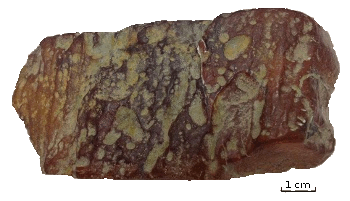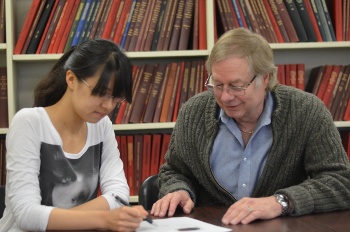Amber and Glass Flow
May 27, 2013
The better
science fiction stories start with a relatively believable premise based on some
scientific fact. In the days of
Mary Shelley's Frankenstein novel, continuing up to the time of the best known
Frankenstein film (Frankenstein, 1931, James Whale, Director),[1] there was the idea of
electricity as a
vital force. It was by electricity that
Victor Frankenstein was able to bring
his monster to life. This idea still lingers in
occult circles.
At the time of its writing in 1990,
Michael Crichton's novel,
Jurassic Park, had the believable plot device that
dinosaur DNA could be extracted from
mosquitoes preserved in
amber, and that dinosaurs could then be
cloned. This plotline, mixed with today's emphasis on
making money from scientific knowledge, made for a
great movie.
Although I wrote about
fossil evidence of giant
fleas sucking dinosaur
blood in a
previous article (Dino Farts and Fleas, May 16, 2012), even if dinosaur blood-sucking mosquitoes were well preserved in amber, the possibility of extracting dinosaur DNA is now thought to be impossible. The "
half-life" of DNA is now estimated to be only about 500
years, so 150 million year old dinosaur DNA is now lost forever.[2-3]
Amber is fossilized tree
resin. The resin consists of
terpenes and
trienes, which crosslink over the years into a hard
polymer mass. One type of amber,
Dominican amber, dates from
Oligocene to
Miocene, so it's about 25 million years old.

A specimen of Dominican amber.
(Photograph courtesy of Gregory McKenna, Texas Tech University)
Although some specimens of amber may be
crystal clear, amber isn't
crystalline, it's a
glass. The distinguishing property of a glass is its
glass transition. Above the glass transition
temperature, glass becomes a
viscous liquid, and it can be manipulated, as by a
glass blower.
One persistent
legend involving
window glass is that it continues to flow after its initial solidification. The evidence being provided is that newer window glass is flat, but window glass from
cathedrals and the
American colonial period are thicker at the bottom than the top.
Modern glass is produced by the
float glass process in which the molten glass is formed on the surface of a pool of molten
tin, so it's uniform in
cross-section throughout. Windows from centuries ago were made from cut sections of glass produced by a spinning process. Spinning caused a thicker cross-section at the edge of the spun
circle.
Tradesmen would naturally mount the window panes with the thicker part downwards, since the thick edge makes a better base.

14th century Gothic rose window.
If window glass did flow at a rapid rate, the fine detail in this window would have dulled after six centuries.
(Via Wikimedia Commons.)
There's abundant
anecdotal evidence that flow of glass at
room temperature doesn't happen.
Arrowheads made from
obsidian (
volcanic glass) still have an edge after thousands of years. Glass
artifacts have been discovered in
Egyptian tombs in a state that appears to be what the
artist intended. Furthermore,
antique telescopes have no apparent
distortion introduced by flow of the glass of their
lenses.[4]
Edgar D. Zanotto published a 1998 paper "Do cathedral glasses flow?" debunking the cathedral glass legend.[5]
Gregory B. McKenna of
Texas Tech University presented the following
calculation relating to the time scale for glass flow at
room temperature.[6]
• Silica glass has a viscosity of 1015.82 Pa-s at 1,000°C.
• Using the reported activation energy, we can calculate that the viscosity at room temperature would be much greater than 1030 Pa-s.
• The Maxwell model allows an estimate of the relaxation time, τ, of a material as τ ≈ η0/G, where η0 is the initial viscosity and G is the shear modulus.
• Since G ≈ 28 GPa for window glass, then t ≈ 1012 years.
McKenna, a
professor of
chemical engineering at Texas Tech University is coauthor of a paper that extends
experimental evidence on glass flow to a 20 million year time scale using measurements on amber.[7-9] Although amber is a
polymeric glass, not an
inorganic glass as in windows, glass
dynamics follow the same laws.[9] Joining him as authors are Texas Tech
graduate student, Jing Zhao, and
Sindee L. Simon, who is
chair of the department.

Jing Zhao and Gregory McKenna of Texas Tech University, two authors of the amber flow study.
(Photograph courtesy of Gregory McKenna.)
The study was undertaken as a result of experiments that Zhao had done on
polyvinyl acetate for her qualifying examination for admittance to the Ph.D. program. The polyvinyl acetate results were unexpected, since they didn't show a
divergence in the relaxation time.[8] At that point, they decided to look at an older glass to extend the time scale of the investigation.
The Texas Tech team did a series of
calorimetric and
stress relaxation experiments on Dominican amber. Their measurement at various temperatures of the amber's relaxation time, the time it takes for the
molecules to rearrange themselves, showed no divergence. This means that it wasn't acting as a
fluid.[7,9] Internal rearrangement of the atoms in the amber specimens was found to have resulted in an increased material
density of just 2.1% in 20 million years.[7,8]
Going for another
order of magnitude in time scale, McKenna has obtained a piece of
Triassic amber that's 220 million years old. This was provided by Eugenio Ragazzi, a professor in the
Department of Pharmacology, the
University of Padua, Italy.[8,10] This research was funded by the
National Science Foundation under a grant from the
Division of Materials Research.[8]
References:
- Frankenstein, 1931, James Whale, Director, on the Internet Movie Database).
- Morten E. Allentoft, Matthew Collins, David Harker, James Haile, Charlotte L. Oskam, Marie L. Hale, Paula F. Campos, Jose A. Samaniego, M. Thomas P. Gilbert, Eske Willerslev, Guojie Zhang, R. Paul Scofield, Richard N. Holdaway and Michael Bunce, "The half-life of DNA in bone: measuring decay kinetics in 158 dated fossils," Proc. R. Soc. B, vol. 279 no. 1748 (December 7, 2012), pp. 4724-4733.
- Matt Kaplan, "DNA has a 521-year half-life," Nature News, October 10, 2012, doi:10.1038/nature.2012.11555.
- Henry Halem, "Does Glass Flow? - The "Glass Flows" Myth," Glass Notes 4.0 Web Site.
- Edgar Dutra Zanotto, "Do cathedral glasses flow?" American Journal of Physics, vol. 66, no. 5 (May, 1998), pp. 392-395.
- Gregory B. McKenna, "Physical Aging in Glasses and Composites," Chapter 7 from Kishore V. Pochiraju, Gyaneshwar P. Tandon and Gregory A. Schoeppner, Eds., "Long-Term Durability of Polymeric Matrix Composites," Springer Science+Business Media, LLC, 2012, DOI 10.1007/978-1-4419-9308-3_7, pp. 237-309.
- Jing Zhao, Sindee L. Simon and Gregory B. McKenna, "Using 20-million-year-old amber to test the super-Arrhenius behaviour of glass-forming systems," Nature Communications, vol. 4, article no. 1783, April 30, 2013.
- Karin Slyker, "Fossil Amber Shatters Theories of Glass as a Liquid," Texas Tech University Press Release, May 7, 2013.
- George Dvorsky, "The 'glass is a liquid' myth has finally been destroyed," io9.com, May 8, 2013.
- Guido Roghi, Eugenio Ragazzi and Piero Gianolla, "Triassic Amber of the Southern Alps (Italy)," PALAIOS, vol. 21, no. 2 (April, 2006), pp. 143-154
Permanent Link to this article
Linked Keywords: Science fiction; science; scientific; Mary Shelley; Frankenstein; Frankenstein film; electricity; vital force; Victor Frankenstein; Frankenstein monster; occult; Michael Crichton; novel; Jurassic Park; dinosaur; DNA; mosquito; amber; cloning; clone; capitalism; making money; Jurassic Park film; fossil; flea; blood; half-life; year; resin; terpene; polyene; triene; polymer; Dominican amber; Oligocene; Miocene; transparent; crystal; crystallinity; crystalline; glass; glass transition; temperature; viscous liquid; glassblowing; glass blower; legend; soda-lime glass; window glass; cathedral; American colonial period; float glass; tin; cross-section; circle; tradesman; Wikimedia Commons; anecdotal evidence; room temperature; arrowhead; obsidian; volcanic glass; artifact; Egypt; Egyptian; tomb; artist; antique; telescope; distortion; lens; Edgar D. Zanotto; Gregory B. McKenna; Texas Tech University; calculation; silica glass; viscosity; pascal; Pa; second; s; Celsius; C; activation energy; Maxwell material; Maxwell model; relaxation time; material; shear modulus; GPa; professor; chemical engineering at Texas Tech University; experiment; polymer; polymeric; inorganic compound; dynamics; graduate student; Sindee L. Simon; chair; polyvinyl acetate; divergence; calorimetry; calorimetric; stress relaxation; molecule; fluid; density; order of magnitude; Triassic; Department of Pharmacology; University of Padua; National Science Foundation; Division of Materials Research; Frankenstein, 1931, James Whale, Director.